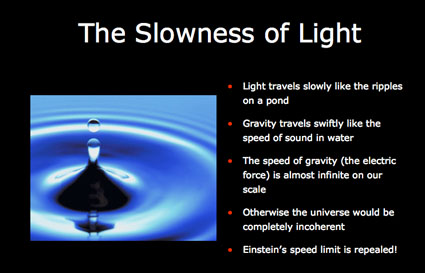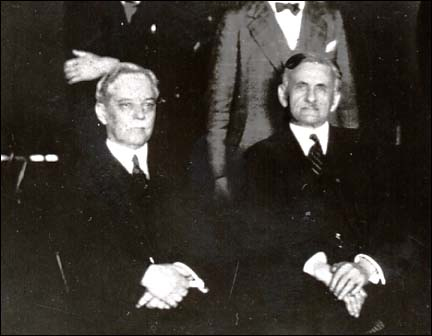Electric Gravity in an Electric Universe

Rubber sheet analogy for “curved space-time.” Artwork by
Starosta.
“..if
a special geometry has to be invented in order to account for a falling apple,
even Newton might be appalled at the complications which would ensue when
really difficult problems are tackled.”
— Sir Oliver Lodge, FRS, 1921. [1]

Credit: London Science Museum.
The fact that we do not understand gravity in this space age should cause alarm. Our cosmology — our view of our situation in the universe — is based on a mystery! The ‘big bang’ is a monumentally expensive work of fiction.
Some History

Birkeland (left) and his Terrella experiment showing
plasma discharge phenomena about a magnetized metal sphere.
We missed a chance to include electricity in astronomy in the early 1900s. Birkeland was performing his electrical ‘little Earth,’ or Terrella, experiments in Norway, and Gauss and Weber were discovering the electrical interactions of matter. Today, physicists labour under misconceptions about the nature of matter and space; the relationship between matter, mass and gravity; the electrical nature of stars[2] and galaxies; and the size, history and age of the universe. So when astrophysicists turn to particle physicists to solve their intractable problems and particle physicists use it as an excuse for squandering billions of dollars on futile experiments, neither party recognizes that the other discipline is in a parlous state.
“After all, to get the whole universe totally wrong in the face of clear evidence for over 75 years merits monumental embarrassment and should induce a modicum of humility.” [3]
How has this situation arisen? In the 20th century technology perfected wireless communication and computers and got man into space, while fundamental science fell deeper into a ‘black hole’ of complication, illogicality and metaphysics. I consider the principal cause has been the usurping, since Einstein, of natural philosophy and physics by theoretical mathematicians. Meanwhile Einstein, perhaps to his credit, remained sceptical of his own work.[6,7]
I have always found it instructive to read what past luminaries of science thought of a radically new idea. The free exchange of opposing opinions is later stifled by the bandwagon effect. Science, like all human endeavours, is subject to fads and fallacies.

Caricature of Sir Oliver Lodge (June 12, 1851 – August
22, 1940).
“..what is really wanted for a truly Natural Philosophy is a supplement to Newtonian mechanics, expressed in terms of the medium which he suspected and sought after but could not attain, and introducing the additional facts, chiefly electrical—especially the fact of variable inertia—discovered since his time…
If we could understand the structure of the particle, in terms of the medium of which it is composed, and if we knew the structure of the rest of the medium also, so as to account for the potential stress at every point—that would be a splendid step, beyond anything accomplished yet.” [8]
[Emphasis added]
This is precisely the Electric Universe view. Natural Philosophy has withered in its confrontation with the modern fashion of mathematical metaphysics and computer games. Most of the ‘discoveries’ now are merely computer generated ‘virtual reality’ — black holes, dark matter, dark energy, etc. The computer models are constructed upon a shadowy kernel of ignorance. We do not understand gravity!
Einstein in his special theory of relativity postulated there was no medium, called the ‘aether.’ But Maxwell’s theory of electromagnetism requires it. And Sir Oliver Lodge saw the aether as crucial to our understanding. So Einstein, at a stroke, removed any possibility that he, or his followers, would find a link between electromagnetism and gravity. It served the egos of his followers to consecrate Einstein’s ideas and treat dissent as blasphemy.
“Sometimes a concept is baffling
not because it is profound but because it’s wrong.” [9,10]
Decades later, Paul R. Heyl wrote in Scientific Monthly, May 1954:
“The more we study gravitation, the more there grows upon us the feeling that there is something peculiarly fundamental about this phenomenon to a degree that is unequalled among other natural phenomena. Its independence of the factors that affect other phenomena and its dependence only upon mass and distance suggest that its roots avoid things superficial and go down deep into the unseen, to the very essence of matter and space.”
—Gravitation: Still
A Mystery.
This sentiment has been echoed down to the present but few are listening. The problem has been worsened by the particle physicists who indulge in their own virtual reality — inventing “virtual particles” to transmit forces. If they “could understand the structure of the particle, in terms of the medium of which it is composed” and put flesh on the metaphysical bones of quantum theory we should be much further advanced. Sir Oliver Lodge deserves to be heard once more:
“..it may be that when the structure of an electron is understood, we shall see that an ‘even-powered’ stress in the surrounding aether is necessarily involved. What I do feel instinctively is that this is the direction for discovery, and what is needed is something internal and intrinsic, and that all attempts to explain gravitation as due to the action of some external agency, whether flying particles or impinging waves, are doomed to failure; for all these speculations regard the atom as a foreign substance — a sort of ‘grit’ in the aether — driven hither and thither by forces alien to itself. When, some day, we understand the real relation between matter and aether, I venture to predict that we shall perceive something more satisfying than that.” [11]
Electric Gravity
In 1850, Faraday performed experiments trying to link gravity with electromagnetism that were unsuccessful. However, his conviction remained:
“The long and constant persuasion that all the forces of nature are mutually dependent, having one common origin, or rather being different manifestations of one fundamental power, has often made me think on the possibility of establishing, by experiment, a connection between gravity and electricity …no terms could exaggerate the value of the relation they would establish.” [12]
Faraday’s estimate of the importance of such a connection still stands. Today, there are a number of scholars pursuing this obvious line of inquiry. After all, the electrical and gravitational forces share fundamental characteristics—they both diminish with the inverse square of the distance; they are both proportional to the product of the interacting masses or charges; and both forces act along the line between them.
Matter and mass
Gravity acts in proportion to the mass of an object. What do we mean when we refer to the ‘mass’ of an object? “One of the most astonishing features of the history of physics is the confusion which surrounds the definition of the key term in dynamics, mass.” [13] Early in the 20th century numerous textbooks equated the mass of an object to its weight. That equation led to confusion because it doesn’t explain why the mass of an object we measure on a weighing machine (gravitational mass) is identical to the mass of that object when we push it (inertial mass).
When it was found that atoms are composed of charged particles, there were attempts to explain mass in terms of electromagnetism. Henri Poincaré wrote in 1914, “What we call mass would seem to be nothing but an appearance, and all inertia to be of electromagnetic origin.” It makes good sense that the equivalence of gravitational and inertial mass should be explained by the electrical structure of matter. However, it is not the philosophical concept of mass but its mathematical treatment that occupies physicists. Einstein’s famous equation, E = mc2, demonstrated that mass and electromagnetic energy are directly related. But mystification resulted when the earlier concept that related mass to ‘quantity of matter’ was unconsciously substituted. Textbooks and encyclopaedias today slip unnoticeably into the error of using the words ‘mass’ and ‘matter’ interchangeably. A NASA educational website tells us that “mass is a measure of how much matter a planet is made of.” It shows that the confusion of mass with quantity of matter infects astrophysics.
The consequences are profound for cosmology. The mass of a celestial body cannot tell us about its composition. We cannot say what the Sun is made from! Another example is comet nuclei, which are electrically charged bodies. They register masses that should have them constructed like an empty sponge yet they look like solid rock. It is their appearance, together with the recently recovered high-temperature minerals (rock particles) from a comet, that give the accurate picture. Comets and asteroids are fragments of planets. They are not primordial—quite the reverse, in fact.
This inexcusable philosophical muddle over matter and mass has given rise to violation of the fundamental physics principle of no creation or annihilation of matter. It has allowed a miraculous cosmological creation story to gain currency, known as the ‘big bang.’ [14] Notions of ‘vacuum energy’ and of particles ‘winking in and out of existence’ in the vacuum of space are similarly miraculous. The simple fact is that we have no concept of why matter manifests with mass.
But when we apply force to a body, how is that force transferred to overcome inertia? The answer is ‘electrically’ by the repulsion between the outer electrons in the atoms closest to the points of contact. The equivalence of inertial and gravitational mass strongly suggests that the force of gravity is a manifestation of the electric force.
The
origin of mass in the electrical nature of matter.

Ralph Sansbury in New York.
Without accepting his model in its entirety, I consider Ralph Sansbury’s straightforward electrical theory of magnetism and gravity[15] to have conceptual merit. Simply stated, all subatomic particles, including the electron, are resonant systems of orbiting smaller electric charges of opposite polarity that sum to the charge on that particle. These smaller electric charges he calls ‘subtrons.’ This is the kind of simplification of particle physics required by Ockham’s razor and philosophically agreeable, though it leaves unanswered the real nature and origin of the subtrons. In this model, the electron cannot be treated like a fundamental, point-like particle. It must have structure to have angular momentum and a preferred magnetic orientation, known vaguely as ‘spin.’ There must be orbital motion of subtrons within the electron to generate a magnetic dipole. The transfer of energy between the subtrons in their orbits within the classical electron radius must be resonant and near instantaneous for the electron to be a stable particle. The same argument applies to the proton, the neutron, and, as we shall see —the neutrino.

This model satisfies Einstein’s view that there must be some lower level of structure in matter to cause resonant quantum effects. It is ironic that such a model requires the electric force between the charges to operate incomparably faster than the speed of light in order that the electron remain a coherent particle. It means that Einstein’s special theory of relativity, that prohibits signalling faster than light, must be repealed. A recent experiment verifies this.
Electromagnetic waves are far too slow to be the only means of signalling in an immense universe. Gravity requires the near-instantaneous character of the electric force to form stable systems like our solar system and spiral galaxies. Gravitationally, the Earth ‘sees’ the Sun where it is this instant, not where it was more than 8 minutes ago. Newton’s famous law of gravity does not refer to time.
We must have a workable concept of the structure of matter that satisfies the observation that the inertial and gravitational masses of an object are equivalent. When we accelerate electrons or protons in an electromagnetic field they become less responsive to the fields the more they are accelerated. This has been interpreted as an increase in particle mass, which is unhelpful until we understand the origin of mass. If the charged subtrons have little intrinsic mass, how do they, in combination, give the electron, proton and neutron the property of mass?
An electric field will transversely squash the subtron orbits within an electron or proton. If you cause acceleration at one point in a circular orbit and a deceleration at the diametrically opposite point of the orbit, the result is an elliptical orbit. In the case of an accelerated particle, the orbit will tend to flatten in the direction of the applied force. It seems that as more energy is supplied to accelerate the particle, the more that energy is assimilated inelastically in further distortion rather than in acceleration. In other words, the electric force becomes less and less effective at acceleration, which Einstein would have us interpret as an increase in mass. For comparison, Weber’s classical approach to the problem has “a decrease in the electrical force and not a change in the inertial mass.” [16] This model implies that the charge centres of a proton at rest are more separated than those in an electron at rest. That allows the proton to distort more readily than an electron in the same electric field and may account for their classical differences in size and mass. “The advantage of this interpretation of the conversion of mass into energy and vice versa is that we are not forced to accept the increase of mass to infinity as a moving mass approaches the speed of light.” [17]
What is gravity?
Gravity is due to radially oriented electrostatic dipoles inside the Earth’s protons, neutrons and electrons. [18] The force between any two aligned electrostatic dipoles varies inversely as the fourth power of the distance between them and the combined force of similarly aligned electrostatic dipoles over a given surface is squared. The result is that the dipole-dipole force, which varies inversely as the fourth power between co-linear dipoles, becomes the familiar inverse square force of gravity for extended bodies. The gravitational and inertial response of matter can be seen to be due to an identical cause. The puzzling extreme weakness of gravity (one thousand trillion trillion trillion trillion times less than the electrostatic force) is a measure of the minute distortion of subatomic particles in a gravitational field.

Celestial
bodies are born electrically polarized from a plasma z-pinch or by core
expulsion from a larger body.
Antigravity?
Conducting metals will shield electric fields. However, the lack of movement of electrons in response to gravity explains why we cannot shield against gravity by simply standing on a metal sheet. As an electrical engineer wrote, “we [don’t] have to worry about gravity affecting the electrons inside the wire leading to our coffee pot.” [19] If gravity is an electric dipole force between subatomic particles, it is clear that the force “daisy chains” through matter regardless of whether it is conducting or non-conducting. Sansbury explains:
“..electrostatic dipoles within all atomic nuclei are very small but all have a common orientation. Hence their effect on a conductive piece of metal is less to pull the free electrons in the metal to one side toward the center of the earth but to equally attract the similarly oriented electrostatic dipoles inside the nuclei and free electrons of the conductive piece of metal.” [20]
This offers a clue to the reported ‘gravity shielding’ effects of a spinning, superconducting disk.[21] Electrons in a superconductor exhibit a ‘connectedness,’ which means that their inertia is increased. Anything that interferes with the ability of the subatomic particles within the spinning disk to align their gravitationally induced dipoles with those of the earth will exhibit antigravity effects.
Despite a number of experiments demonstrating antigravity effects, no one has been able to convince scientists attached to general relativity that they have been able to modify gravity. This seems to be a case of turning a blind eye to unwelcome evidence. Support for antigravity implicitly undermines Einstein’s theory.[22]
‘Instantaneous’ gravity
A significant fact, usually overlooked, is that Newton’s law of gravity does not involve time. This raises problems for any conventional application of electromagnetic theory to the gravitational force between two bodies in space, since electromagnetic signals are restricted to the speed of light. Gravity must act instantly for the planets to orbit the Sun in a stable fashion. If the Earth were attracted to where the Sun appears in the sky, it would be orbiting a largely empty space because the Sun moves on in the 8.3 minutes it takes for sunlight to reach the Earth. If gravity operated at the speed of light all planets would experience a torque that would sling them out of the solar system in a few thousand years. Clearly, that doesn’t happen. This supports the view that the electric force operates at a near infinite speed on our cosmic scale, as it must inside the electron.[23] It is a significant simplification of all of the tortuous theorizing that has gone into the nature of gravity and mass. Einstein’s postulates are wrong. Matter has no effect on empty space. Space is three-dimensional—something our senses tell us. There is a universal clock so time travel and variable aging is impossible—something that commonsense has always told us. But most important—the universe is connected and coherent.
The real nature of light
However, it leaves the question of what the speed of light means. This is where I part company with Sansbury and others who explain it in terms of a delayed response to an instantaneous signal. In my view, the crucial difference between the near-infinite speed of the electric force and the relative dawdle of light on any cosmic scale is that the electric force is longitudinal while light is an oscillating transverse signal moving slowly through a medium.

If I can use a simple analogy, light travels slowly like the transverse ripples on a pond surface; gravity travels swiftly and longitudinally, like the speed of sound in water. Once again, this is at odds with Einstein’s metaphysics because it reinstates Maxwell’s aether: Maxwell’s electromagnetic theory requires a medium. How can you wave nothing?
The Michelson-Morley basement experiment was heralded as having lain to rest the notion of an aether. It didn’t.[24] Dayton Miller carried out far more rigorous repeats of that experiment at different locations and elevations. He found a residual, which allowed him to conclude that ponderable bodies like the Earth drag the aether with them. He was able to determine the relative motion of the solar system with respect to the aether.

Dayton Miller (left) with Irving Michelson (right).
Credit: Case WRU Archives. “Miller’s work on ether drift was clearly undertaken
with more precision, care and diligence than any other researcher who took up
the question, including Michelson, and yet, his work has basically been written
out of the history of science.”
Others and I have argued that a plenum of neutrinos forms the aether.[25] Based upon nuclear experiments, I have also proposed that neutrinos are the most collapsed, lowest energy state of matter. In other words they exhibit vanishingly small mass. However, being normal matter composed of subtrons, they are capable of forming electric dipoles. In an oscillating electromagnetic field a neutrino must rotate through 360˚ per cycle. That would link the speed of light in a vacuum to the moment of inertia of a neutrino. Having some mass, neutrinos must be ‘dragged along’ by gravitating bodies. They form a kind of extended ‘atmosphere’ which will bend light. It has nothing to do with a metaphysical ‘warping of space.’
The Electric Universe
The confusion about any role for electricity in celestial dynamics has come about because of our ignorance of the electrical nature of matter and of gravity. The classical signposts to an understanding of gravity were in place at the beginning of the 20th century, but after the terrible world wars it seems people were looking for heroes with a new vision. Einstein became an overnight idol of genius and his geometric metaphysics the new fashion in science. The dedication to the Einstein myth has become so entrenched that to say “the emperor has no clothes” invites ridicule. But over almost a century there has been an astronomical price to pay for unquestioning adherence to dogma. A recent review of the history of astronomy concludes,
“The inability of researchers to rid themselves of earlier ideas led to centuries of stagnation. An incredible series of deliberate oversights, indefensible verbal evasions, myopia, and plain pig-headedness characterize the pedestrian progress along this elusive road for science. We must be constantly on our guard, critically examining all the hidden assumptions in our work.” [26]
Since scientists have demonstrated their inability to do this, the public must be made aware how science actually operates and is protected from scrutiny. It will require the kind of fearless investigative journalism we often see in politics. Unfortunately, science reporters are part of the problem if they bow to the expert and the lazy dissemination of academic propaganda.
Ultimately cosmology must have no loose ends. The electric universe model is an attempt to connect many strands of knowledge. “Proposals that eventually pan out in the world are far more likely to exhibit narrative consistency – perhaps what Edward O. Wilson calls ‘consilience’ in his book of that name.” [27] “The goal of consilience is to achieve progressive unification of all strands of knowledge in service to the indefinite betterment of the human condition.” [28]
No matter that there is an avalanche of books and papers supporting big bang cosmology—repetition provides no assurance that one particular interpretation of results is valid. “Assurance of interpretation can come only by comparing the success of competing hypotheses in interpreting data from disparate areas.”[29] Big bang cosmology fails this test because it brooks no competition.
For example, plasma cosmology is officially recognized by the largest professional organization in the world, the Institute of Electrical and Electronic Engineers (IEEE), while big bang cosmologists ignore it. The electric universe model is an extension of plasma cosmology. It is based on concepts derived from observations as disparate as petroglyphs and quasar redshift. Big bang cosmologists have no narrative that can compete. But by the simple act of ignoring alternatives they reject them—if the public simply acquiesce and do not speak up.
-
Wal
Thornhill
REFERENCES
[1] Sir Oliver Lodge, F.R.S., The Geometrisation of Physics, and its supposed Basis on the Michelson-Morley Experiment. Nature, Feb 17, 1921, p. 797.
[2] W. Thornhill, The Z-Pinch Morphology of Supernova 1987A and Electric Stars, IEEE Transactions on Plasma Science, Vol. 35, No. 4, August 2007, pp. 832-844.
[3] Halton Arp, What has Science Come to?, Journal of Scientific Exploration, Vol. 14, No. 3, 2000, pp. 447–454.
[4] D. L. Hotson, Dirac’s Equation and the Sea of Negative Energy, Infinite Energy, issue 43, 2002, p. 4. It was noted by H. C. Dudley in Smithsonian, Vol. 5, No. 7, October 1974, that, “Dirac advised a group of U.S. physicists to stop looking for more and more particles and direct their efforts elsewhere.”
[5] Vesselin Petkov, Did 20th century physics have the means to reveal the nature of inertia and gravitation?, arXiv:physics/0012025v3, 17 Dec 2000.
[6] Albert Einstein, “You can imagine that I look back on my life’s work with calm satisfaction. But from nearby it looks quite different. There is not a single concept of which I am convinced that it will stand firm, and I feel uncertain whether I am in general on the right track.” Personal Letter to Professor Solovine, dated 28 March 1949. Quoted in B. Hoffman, Albert Einstein-Creator and Rebel (N.Y.: Viking Press, 1972).
[7] Lee Smolin, Einstein’s Lonely Path, DISCOVER 30/9/2004, “Special relativity was the result of 10 years of intellectual struggle, yet Einstein had convinced himself it was wrong within two years of publishing it. He had rejected his theory, even before most physicists had come to accept it.”
discovermagazine.com/2004/sep/einsteins-lonely-path/
[8] Sir Oliver Lodge, op. cit., p. 799.
[9] Edward O. Wilson, The Biological Basis of Morality, The Atlantic Monthly, Vol. 281, No. 4, April 1998, pp. 53-70.
[10] Stephen J. Crothers, A Brief History of Black Holes, Progress in Physics, Vol. 2, April 2006, pp. 54-7. See online at
www.sjcrothers.plasmaresources.com/index.html “Einstein ..did not understand the basic geometry of his gravitational field. Other theoreticians obtained the black hole from Einstein’s equations by way of arguments that Einstein always objected to. But Einstein was over-ruled by his less cautious colleagues, who also failed to understand the geometry of Einstein’s gravitational field.”
[11] Oliver Lodge, University of Birmingham, March 25, 1911. Letters to the Editor, Nature, Volume 87, March 30, 1911.
[12] M. Faraday, Experimental researches in electricity, Vol. 3. Dover Publications Inc., New York, 1965, pp 161-168.
[13] G. Burniston Brown, Gravitational and Inertial Mass, American Journal of Physics 28, 475 (1960).
[14] Mike Disney, The Case against Cosmology, General Relativity and Gravitation, 32, 1125, 2000. “The most unhealthy aspect of cosmology is its unspoken parallel with religion. Both deal with big but probably unanswerable questions. The rapt audience, the media exposure, the big book-sale, tempt priests and rogues, as well as the gullible, like no other subject in science.”
[15] mysite.verizon.net/r9ns/
[16] A. K. T. Assis’ and R. A. Clemente, The Ultimate Speed Implied by Theories of Weber’s Type, Int. J. Theoretical Physics. Vol. 31, No. 6, 1063-73 (1992).
[17] R. Sansbury, The Infinite or Finite Speed of Gravity and Light?, CP Institute, N.Y., 1994, p. 123.
[18] R. Sansbury, The Common Cause of Gravity and Magnetism, p 1. See
www.magna.com.au/~prfbrown/news96_f.html
[19] D. E. Scott, The Electric Sky: A Challenge to the Myths of Modern Astronomy, Mikamar Publishing, 2006, p. 73.
[20] R. Sansbury, op. cit., p.15.
[21] E. Podkletnov, Weak gravitation shielding properties of composite bulk Y Ba2Cu3O7-x superconductor below 70 K under e.m. field,
arxiv.org/abs/cond-mat/9701074v3
[22] Boemer, Examples of Suppression in Science, “Mainstream physics also thinks that it can dismiss anti-gravity and gravity shielding experiments, using circular reasoning rivaling that of fundamentalist theology: since no experiment has ever contradicted general relativity, general relativity must be true, and anti-gravity and gravity shielding effects cannot possibly be real, since they would contradict general relativity.”
[23] T. Van Flandern, The Speed of Gravity – Repeal of the Speed Limit, Meta Research, On the basis of 6 experiments the lower limit for the speed of gravity is 2×1010 c.
[24] R. T. Cahill, The Einstein Postulates: 1905-2005—A Critical Review of the Evidence, “There is a detectable local frame of reference or ‘space,’ and the solar system has a large observed galactic velocity of some 420±30km/s in the direction (RA=5.2hr, Dec= -67deg) through this space.”
[25] See for example, H. C. Dudley, Is there an ether? Industrial Research, Nov 15, 1974, pp. 43-6.
[26] Simon Mitton, reviewing The Milky Way by Stanley L. Jaki, New Scientist, 5 July 1973, p. 38.
[27] W. Paschelles, New Scientist, 13 January 2007, pp. 18-19.
[28] Charles C. Gillispie, E. O. Wilson’s Consilience: A Noble, Unifying Vision, Grandly Expressed, American Scientist, May-June 1998.
[29] J. A. Hewitt, A Habit of Lies, Chapter 2; Scientific Logic and Method.
From The Electric
Universe @ http://www.holoscience.com/wp/electric-gravity-in-an-electric-universe/
For more information about gravity see http://nexusilluminati.blogspot.com/search/label/gravity
- Scroll down
through ‘Older Posts’ at the end of each section
Do you LIKE this uniquely informative site?
Hours of effort by a genuinely incapacitated invalid are
required every day to maintain, write, edit, research, illustrate, moderate and
publish this website from a tiny cabin in a remote forest.
Now that most people use ad blockers and view these posts
on phones and other mobile devices, sites like this earn an ever shrinking
pittance from advertising sponsorship. This site needs your help.
Like what you see? Please give anything you can -
Contribute any amount and receive at least one
New Illuminati eBook!
(You can use a card securely if you don’t use Paypal)
Please click below -
Spare Bitcoin
change?
And it costs nothing
to share this post on Social Media!
Dare to care and
share - YOU are our only advertisement!
Video - https://youtu.be/YkWiBxWieQU
For further enlightening
information enter a word or phrase into the random synchronistic search box @
the top left of http://nexusilluminati.blogspot.com
And see
New Illuminati – http://nexusilluminati.blogspot.com
New Illuminati on Facebook - https://www.facebook.com/the.new.illuminati
New Illuminati Youtube Channel - https://www.youtube.com/user/newilluminati/playlists
New Illuminati’s OWN Youtube Videos
-
New Illuminati on Google+ @ For
New Illuminati posts - https://plus.google.com/u/0/+RamAyana0/posts
New Illuminati on Twitter @ www.twitter.com/new_illuminati
New Illuminations –Art(icles) by
R. Ayana @ http://newilluminations.blogspot.com
The Her(m)etic Hermit - http://hermetic.blog.com
DISGRUNTLED SITE ADMINS PLEASE NOTE –
We provide
a live link to your original material on your site (and links via social
networking services) - which raises your ranking on search engines and helps
spread your info further!
This site
is published under Creative Commons (Attribution) CopyRIGHT (unless an
individual article or other item is declared otherwise by the copyright
holder). Reproduction for non-profit use is permitted & encouraged - if you
give attribution to the work & author and include all links in the original
(along with this or a similar notice).
Feel free
to make non-commercial hard (printed) or software copies or mirror sites - you
never know how long something will stay glued to the web – but remember
attribution!
If you
like what you see, please send a donation (no amount is too small or too large)
or leave a comment – and thanks for reading this far…
Live long
and prosper! Together we can create the best of all possible worlds…
From the New Illuminati – http://nexusilluminati.blogspot.com
Space, Energy, Mass/ The universe is made of one kind of entity.
ReplyDeleteThere are two states of being: expanded and contracted.
Standing momentum forward, standing momentum inward. An entity must be in
one state or the other at any given instant. It must sustain either state at will.
Expanded entitites are space. They are permeable, they offer no impedance to each other.
A contracted entity is mass. Mass entities are not permeable. They are anti-space.
All energy is the appearance of entities when constantly changing from space to mass, mass to space, without resting in either state.
There is one fundamental physical interaction between entities, Space Propels Mass. It is the propulsive effect of space on mass that we know as the force of gravity. All other relations & systems are built on this interaction. Energy is never as conscious as space, nor as unconcious as mass. We say that matter is drawn to the center of the planet by gravity. The pressure of space on mass insures that in time every entity will move to the vicinity of others with the same time-lengths in state.
Space, Mass, or Energy. Simple laws can easily build complex systems, but complex laws would have an impossible labor to create the predictions of physics and geometry.
A mass entity alone will not move, since it is surrounded by space equally. when 2 or more entities are contracted, they will be propelled toward each other, since there is less propulsive effect. If an entity stays contracted long enough it will be pushed together with other mass. The larger the gathering of mass, the less counter-active space propulsion there is at the center, as supported by the equivalence of the formulas for acceleration and gravity. The expansive momentum of space entities is 2c. Since energy is expanded half the time, its waves move at velocity c.
The universe is a field of space (any number of space entities) which maintains a constant and uniform pressure on any contracted entities. The pattern of space-energy-mass relations can be applied in modified form to any local context, gas-liquid-solid, vaporized-fluid-frozen. The force of gravity depends on the amount of mass. The only real force in the universe is that space propels mass, this does not give space (unimpeded consciousness entities) the power to control energy & mass in any specific way. The propulsion is uniform & identical everywhere-it is what we now think of the force of gravity. Space merely pushes away any contracted entities. Mass moves toward other mass because that is always the direction in which there is less space, less propulsion. The more mass entites are pushed together, the more intense the pressure, not because space is pushing harder, but merely because there is no counter-propulsion at the center of a gathering of mass.
"Love and Pain" by Thaddeus Golas